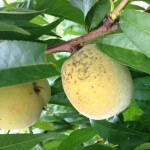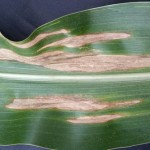Fruit:
Apples are progressing in fruit development and overall the crop looks very good. Codling moth numbers started to tick upward in a few traps this week. Sooty blotch, one of our summer fungal diseases was noted on some apples this week. (see photo below) Growers need to stay on a fungicide program to prevent both sooty blotch and fly speck disease development during the summer. All apple maggot traps remained negative the week of July 13-17, though one apple maggot fly was noted by a scout on an apple leaf. Other insects noted at below threshold levels in orchards included green apple aphids, wooly apple aphids, leafminers and Japanese beetles. European red mites and 2-spotted spider mites were found at threshold levels in one orchard.
Peaches are also developing with minimal pest issues being noted. Oriental fruit moth trap captures remained high this week, while trap captures for the greater and lesser peach tree borer moths remained at 0 in all orchards. Peach scab was noted on some fruit in one orchard. Fungicide sprays to prevent brown rot and scab must be maintained. (see photo below)
There were positives once again this weekin the spotted wing drosophila (SWD) traps. Commercial small fruit growers should be spraying ripe fruit and fruit that is beginning to ripen to protect against SWD infestation. Rotate between chemical classes of approved insecticides.
Other than SWD, powdery mildew is showing up in grapes and growers need to be on a fungicide program to prevent damage from this disease. Black raspberry harvest is wrapping up and red raspberries are being harvested. Blueberries are ripe and picking has begun. Some low levels of phomophsis blight have been seen. Japanese beetles are present in low levels and birds are working on some of the berries.
Vegetables:
The continued wet weather is causing all sorts of issues. Diseases, both fungal and bacterial are present at varying levels in fields, and wet, saturated soils are causing nitrogen loss, some root damage, and yellow plants in some areas. Despite this, growers are harvesting and plants are producing. Use of fungicide spray programs, where appropriate, is a key component in production at this point.
The tomato hornworm showed up in scouting reports in both high tunnel and field grown tomatoes. (See Photo below) Despite their size they are difficult to actually locate because they blend in to the plant so well. Damage symptoms and frass are the first clues noted. Other insect pests noted in high tunnel production, all below threshold levels, are: aphids, white flies and stink bugs.
The most serious disease problems in both field and high tunnel grown tomatoes are septoria leaf spot and early blight. In warm, wet conditions, septoria can rapidly defoliate a plant if not managed early with an effective and consistent fungicide spray program. Bacterial spot is also showing up, mainly in field tomatoes and growers are being advised to not work with the plants when they are wet, practice good sanitation between infected and non-infected plants and maintain a copper spray program to suppress the disease. In high tunnel production scouts are also finding fusarium crown rot, leaf mold, botrytis gray mold, timber rot and yellow shoulder.
Garlic is maturing tops are beginning to dry down. In onions, thrip populations have remained low. Onion harvest is also beginning with generally good bulb size being reported. Cole crops overall look good. The new plantings for a planned fall harvest had both slug damage and imported cabbage worm eggs noted. Established plantings are at the almost ready to harvest to harvest underway stage. Some bacterial soft rot was noted in some plants of one planting by scouts. Imported cabbage worm larvae were found and in some fields were at economic treatment threshold.
In vine crops, many plantings of summer squash and zucchini are at the point of harvest, fall squash and pumpkins are in bloom, melons are at fruit set, and cucumbers range from new plantings to harvest. Downy mildew was found in more cucumber fields this past week. Bacterial wilt is also being found in some cucumbers. Growers are being advised to use a fungicide spray program on a 5-7 day schedule to protect against downy mildew. Cucumbers are most vulnerable followed by cantaloupe and then squash, pumpkins and watermelon. Powdery mildew was noted by scouts in summer squash, fall squash, pumpkins and cucumbers this week.
Angular leaf spot, a bacterial disease has been found across all vine crops and in many fields. Anthracnose and alternaria leaf spot have also been found and growers need to be on a good fungicide spray program. Bacterial wilt, a disease vectored by cucumber beetles was noted by scouts in both melons and cucumbers this week. Cucumber beetles ranged from low numbers to above treatment threshold levels. Deer damage was noted by scouts in a number of fields.
Peppers are developing fruit with some ready to harvest. In some plantings, bacterial spot is present. Scouts also noted some Fusarium crown rot and mosaic virus in some plants this week. (See photo below). Japanese beetles, zebra caterpillars, stinkbugs and aphids were all found at low levels in some fields. Eggplant is doing well but there are plants with verticillium wilt and anthracnose. Colorado potato beetles were noted at above threshold levels in some field this week. Japanese beetles are present in low numbers.
Green beans vary from newly emerging to harvest. Overall quality is good, no disease has been noted. In some plantings there are Japanese beetles that have caused defoliation above the 30% threshold level. Other insect pests noted at below threshold levels include slugs, bean leaf beetles and grasshoppers.
Sweet corn, due to staggered plantings, ranges from newly emerging to harvest. Only 2 corn earworm moth was caught between traps at 4 locations this week. European corn borer moth captures ranged from 0 to 2 between 4 trap locations. Feeding by snails, slugs, European corn borer larvae, Japanese beetles, grasshoppers and fall armyworm was noted by scouts this week. In one field the level of Northern corn leaf blight in pre-tassel corn was above threshold level and a fungicide spray was recommended.
Potatoes overall look good. Some plantings are ready for harvest. Colorado potato beetle is at threshold levels in some plantings and under control in others. Low numbers of potato leaf hoppers and flea beetle were noted. Some light levels of early blight were found in one planting.
Agronomic Field Crops:
Corn ranges in development from v-8 to R2 (blister). In some fields lower leaves are turning yellow due to nitrogen shortage as the plant mobilizes nitrogen from older leaves to use for younger leaf growth. Wet soils have caused nitrogen loss through both denitrification and leaching. Grey leaf spot in some fields and some varieties is at levels that may warrant a fungicide spray at stage V-T. Northern corn leaf blight is also being seen in some fields but at low levels. (See photo below) European corn borer, Japanese beetles and grasshoppers are all being noted at low levels in some fields. Deer damage is also being noted.
In low areas and poorly drained areas water is standing in some fields and soybean growth and development is suffering. Root rot has been noted. In other fields soybean growth looks good and soybeans are at pod development, R3-4. Scouts are noting brown spot on the lower leaves of most soybean fields. Bacterial leaf blight has been found in some fields. White mold is just starting to show up in pockets but generally low levels. Leaf defoliators including bean leaf beetle, Japanese beetles, grasshoppers, Bean leaf beetles and slugs have all been noted on scouting reports. (See photo below) No western bean cutworm moths have been captured in traps to this point.
Alfalfa is being monitored for potato leaf hoppers. Populations are still low at this time. Some yellowing of alfalfa plants is not due to leafhoppers, but rather wet soils. Alfalfa roots are struggling in low areas and wet soils. Plant collapse is being noted in some wheel track areas where harvesting took place on wet soils.







